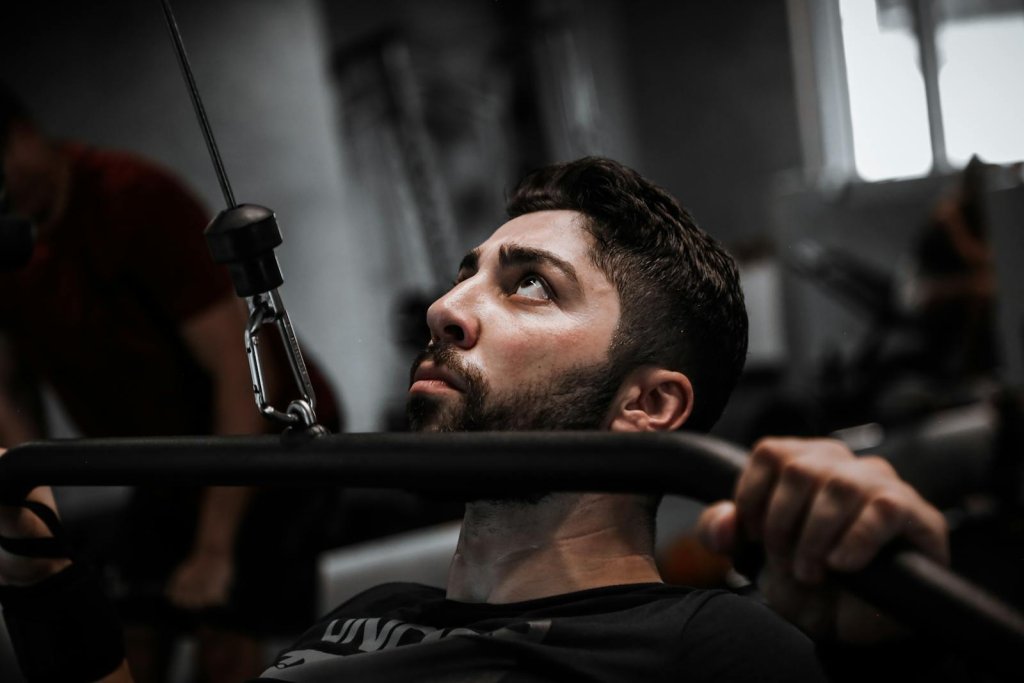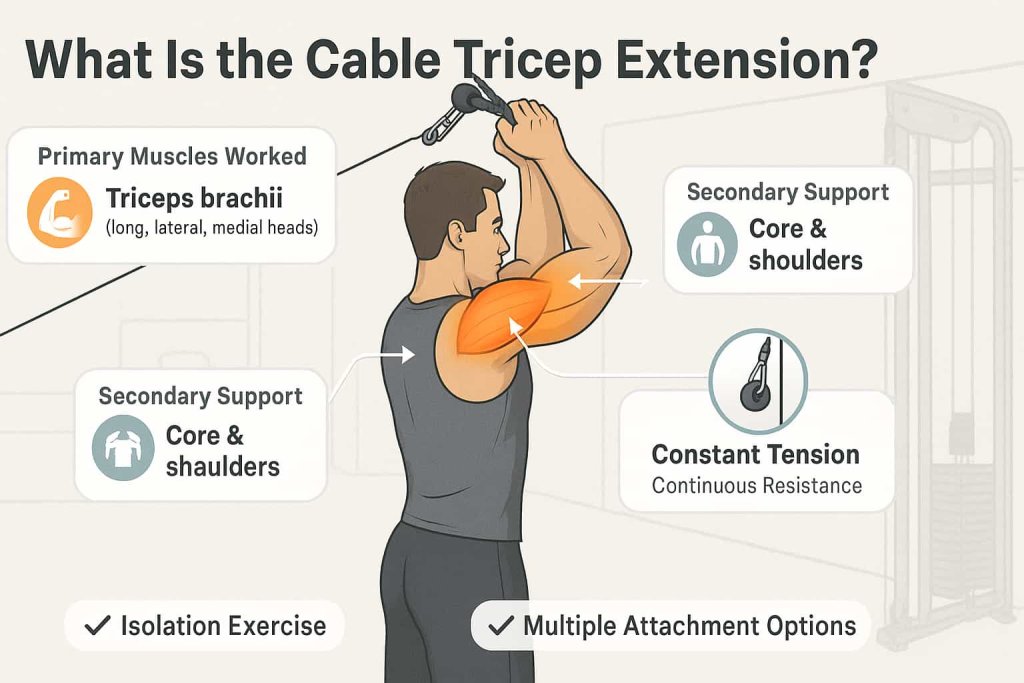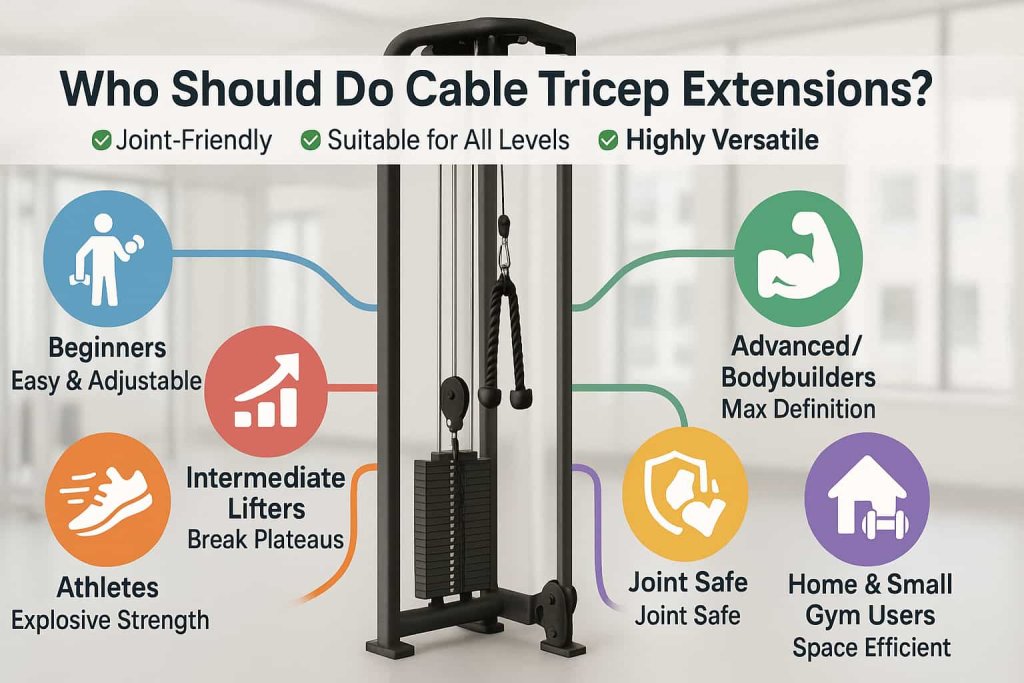The cable tricep extension is one of the best exercises to build stronger, more defined arms. This move directly targets all three heads of your triceps—especially the long head—giving you that horseshoe-shaped muscle definition while improving pressing strength.

It’s important to understand the correct technique, variations, and mistakes to avoid so you don’t waste time or risk injury. With the right form, you can maximize results and make your arm workouts more effective. In this guide, you’ll learn how to perform cable tricep extensions properly, explore variations, and pick the best rep ranges for your goals.
What Is the Cable Tricep Extension?
The cable tricep extension is an isolation exercise performed on a cable machine. Unlike free weights, cables provide constant tension throughout the movement, which keeps your triceps under load from start to finish.

You can perform this exercise with a rope, straight bar, V-bar, or single handle, depending on your preference and goal.
Muscles Worked:
- Primary: Triceps brachii (long, lateral, and medial heads)
- Secondary: Core stabilizers and shoulders (for support)
Benefits of Cable Tricep Extension

- Constant Tension: Cables keep your muscles engaged throughout the full range of motion.
- Joint-Friendly: Smooth resistance is easier on the elbows compared to dumbbell or barbell extensions.
- Long Head Emphasis: Overhead variations specifically target the long head, which contributes to tricep fullness.
- Strength Carryover: Stronger triceps improve your bench press, push-ups, and overhead presses.
- Versatility: Multiple attachments and angles let you train your triceps in different ways.
How to Do Cable Tricep Extension (Step-by-Step)
- Set Up the Machine
Attach a rope or bar to the low pulley of a cable station. - Get Into Position
Face away from the machine. Grab the handle and bring your arms overhead, elbows close to your ears. - Brace Your Core
Stand tall, engage your abs, and avoid overarching your lower back. - Lower Slowly
Bend your elbows to bring the handle behind your head under control. - Extend to Lockout
Push the handle upward by straightening your elbows. Pause at the top. - Repeat for Reps
Perform 3–4 sets in your chosen rep range.
👉 Trainer Tip: Keep elbows tucked and avoid flaring out—think “framing your face” with your arms.
Common Mistakes to Avoid
- ❌ Elbow Flare → Reduces tricep activation, stresses shoulders.
- ❌ Overarching Back → Caused by using too much weight; brace your core instead.
- ❌ Partial Reps → Limits muscle growth. Use full range of motion.
- ❌ Losing Tension at Top → Keep constant control—don’t let the weight stack touch.
Best Variations of Cable Tricep Extension
Cable tricep extensions are one of the best ways to build arm size, definition, and strength. Unlike free weights, cables keep constant tension on your triceps, leading to better muscle activation. Here are the top variations you can use to target different parts of the triceps and avoid plateaus.
1. Rope Overhead Extension
Why it works:
- The rope allows you to rotate your wrists outward at the end of the movement.
- This creates a stronger contraction and helps develop the “horseshoe” shape of the triceps.
Muscles Worked: Long head of the triceps (primary), with assistance from medial and lateral heads.
How to Do It:
- Attach a rope to the low pulley.
- Hold the rope with both hands and step forward.
- Raise the rope overhead with elbows close to your head.
- Extend arms fully, then slowly return to the starting position.
Trainer Tip: Focus on spreading the rope apart at the bottom for maximum triceps activation.
2. Straight Bar Overhead Extension
Why it works:
- Using a straight bar gives more stability compared to the rope.
- You can load heavier weight, making it great for strength and size.
Muscles Worked: Long head of triceps (emphasis), with support from lateral head.
How to Do It:
- Attach a straight bar to the cable.
- Grip with palms facing down (overhand).
- Bring the bar overhead with elbows tucked in.
- Extend arms fully and control the bar back.
Trainer Tip: Keep your core tight and avoid arching your back when handling heavier weight.
3. Single-Arm Cable Extension
Why it works:
- Helps correct muscular imbalances between arms.
- Forces your core to stabilize since one side is working independently.
Muscles Worked: All three tricep heads, with focus on form and stability.
How to Do It:
- Attach a single handle to the cable.
- Hold the handle in one hand and bring it overhead.
- Keep elbow close to your head and extend the arm.
- Repeat on the other side.
Trainer Tip: Use lighter weight for strict form—don’t let your elbow drift out.
4. Lying Cable Extension
Why it works:
- Similar to a skull crusher but smoother because the cable reduces joint stress.
- Constant tension protects elbows while still giving a deep stretch.
Muscles Worked: Long head and lateral head of triceps.
How to Do It:
- Set a flat bench in front of the low pulley.
- Lie down and grab the bar/rope with arms extended above chest.
- Bend elbows, lowering the bar toward your forehead.
- Extend arms back up under control.
Trainer Tip: Don’t flare elbows out—keep them tucked for maximum tricep activation.
5. Reverse-Grip Cable Extension
Why it works:
- Using an underhand grip shifts emphasis onto the medial head of the triceps.
- Great for adding detail and full-arm development.
Muscles Worked: Medial head (primary), with secondary activation of long and lateral heads.
How to Do It:
- Attach a straight bar to the high pulley.
- Grab the bar with an underhand (supinated) grip.
- Keep elbows close to sides and extend arms down fully.
- Control the return to starting position.
Trainer Tip: Go lighter than normal—underhand grip limits weight capacity but improves control and isolation.
Who Should Do Cable Tricep Extensions?

Cable tricep extensions are suitable for almost every fitness level because they are joint-friendly, adjustable, and versatile.
- Beginners → Great introduction to triceps training since the cable provides a smooth resistance curve and easy weight adjustments.
- Intermediate Lifters → Helps break plateaus and develop the long head of the triceps for fuller arm development.
- Advanced Lifters & Bodybuilders → Essential for refining tricep definition and adding volume after heavy compound pressing.
- Athletes → Improves lockout strength in pushing movements like football blocking, boxing punches, or overhead throws.
- Those with Elbow Discomfort → Cables reduce joint stress compared to heavy free-weight extensions, making them a safer option.
- People Training at Home or in Small Gyms → A cable station with multiple attachments allows a wide range of variations in limited space.
👉 In short: If you want bigger, stronger, and healthier triceps, cable tricep extensions are for you.
Programming: Sets, Reps & Goals
- Strength: 3–5 sets × 4–6 reps (heavier loads, bar or V-bar).
- Hypertrophy (muscle growth): 3–4 sets × 8–12 reps (rope or bar).
- Endurance & Definition: 3–4 sets × 12–20 reps (lighter weight, high control).
👉 Pro Tip: Pair cable tricep extensions with compound pressing moves like bench presses or dips for maximum arm growth.
FAQs About Cable Tricep Extension
1. Is cable tricep extension better than dumbbell overhead extension?
Yes. Cables keep constant tension on your triceps, making them more effective and joint-friendly than dumbbells.
2. Which grip is best for triceps growth?
Rope handles allow wrist rotation for maximum contraction, while bars allow heavier loading.
3. How often should I do cable tricep extensions?
2–3 times per week, as part of your arm or push day.
4. Can beginners do cable tricep extensions?
Absolutely. Start with light weight, rope attachment, and focus on form.
5. What’s the difference between pushdowns and extensions?
Pushdowns emphasize lateral and medial heads; overhead extensions hit the long head harder.
6. Should I lock out my elbows at the top?
Yes, but do it under control—don’t snap your elbows.
7. Can I superset cable tricep extensions with biceps?
Yes. Pairing them creates an effective arm workout (antagonist superset).
Conclusion
The cable tricep extension is a must-have move for building strong, defined arms. By keeping your elbows tucked, bracing your core, and controlling the weight, you’ll maximize tricep activation and avoid common mistakes.
Mix in different variations, adjust your rep ranges, and stay consistent—you’ll see real results in both strength and aesthetics.
👉 Ready to build bigger arms? Add cable tricep extensions to your next workout and feel the difference.
